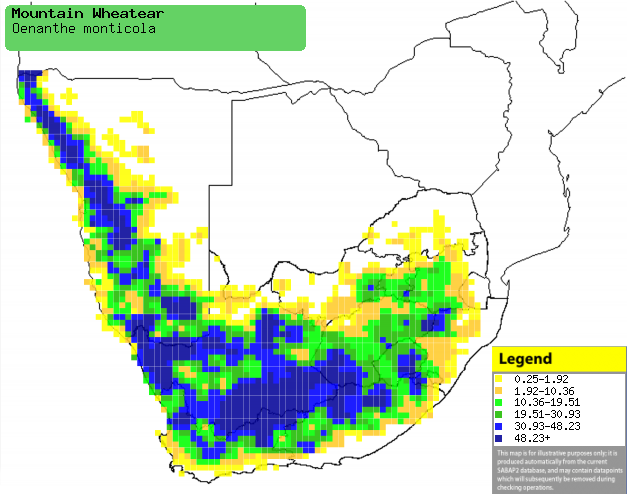|
Oenanthe monticola (Mountain
wheatear,
Mountain chat)
Bergwagter [Afrikaans]; Khaloli, Letšoana-tšoana,
Letšoanafike [South Sotho]; Bergtapuit [Dutch]; Traquet montagnard
[French]; Bergschmätzer [German]; Chasco-montês [Portuguese]
Life
> Eukaryotes >
Opisthokonta
> Metazoa (animals) >
Bilateria >
Deuterostomia > Chordata >
Craniata > Vertebrata (vertebrates) > Gnathostomata (jawed
vertebrates) > Teleostomi (teleost fish) > Osteichthyes (bony fish) > Class:
Sarcopterygii (lobe-finned
fish) > Stegocephalia (terrestrial
vertebrates) > Tetrapoda
(four-legged vertebrates) > Reptiliomorpha > Amniota >
Reptilia (reptiles) >
Romeriida > Diapsida > Archosauromorpha > Archosauria >
Dinosauria
(dinosaurs) > Saurischia > Theropoda (bipedal predatory dinosaurs) >
Coelurosauria > Maniraptora > Aves
(birds) > Order: Passeriformes
> Family: Muscicapidae > Genus: Oenanthe
Distribution and habitat
Near-endemic to southern Africa, occurring from south-west
Angola through Namibia to South Africa. It generally prefers boulder-strewn
hillsides with scattered bushes, old mine workings, small cliffs, farmyards and
gardens of houses on rocky slopes.
|
 |
|
Distribution of Mountain wheatear in southern Africa,
based on statistical smoothing of the records from first SA Bird Atlas
Project (©
Animal Demography unit, University of
Cape Town; smoothing by Birgit Erni and Francesca Little). Colours range
from dark blue (most common) through to yellow (least common).
See here for the latest distribution
from the SABAP2. |
Predators and parasites
It has been recorded as prey of the Common
fiscal (Lanius collaris).
Brood parasites
It has been recorded as host of the
Diderick
cuckoo.
Food
It mainly eats invertebrates, often foraging on the ground
and on rocks, plucking smaller prey leisurely but also chasing and stabbing
larger invertebrates. It may also forage from a perch, pouncing on prey on the
ground or hawking them in the air. The following food items have been recorded
in its diet:
Breeding
- The nest (see image below) is constructed solely by the female in about 4-14 days,
consisting of a shallow cup set into an untidy platform built of a variety
of materials, such as grass, woody stems, twigs, trapdoor spider webs, petioles, dried
flowers, seeds, larval and pupal
Lepidoptera cases, dried moss, pebbles, dung and snake skin. It is typically
placed beneath a boulder, in a crevice set into a rock, wall or building or
in a box-shape structure, such as a nest box or cupboard.
- Egg-laying season is from June-March, peaking from September-November.
- It lays 2-4 eggs, which are incubated solely by the female for about 13
days, occasionally leaving the nest to forage while the male defends the
territory.
- The chicks are brooded by the female at night for the first 10 days of
their lives, with both adults feeding them on a diet of insects and
Arthropods. They eventually leave the nest after about 14-17 days, becoming
fully independent about a month later.
Threats
Not threatened.
References
-
Hockey PAR, Dean WRJ and Ryan PG 2005. Roberts
- Birds of southern Africa, VIIth ed. The Trustees of the John Voelcker
Bird Book Fund, Cape Town.
|
